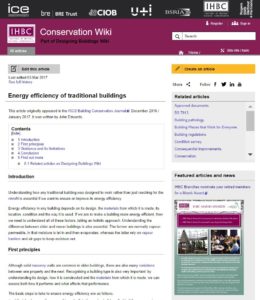 IHBC trustee John Edwards has posted his RICS Conservation Journal article on ‘Energy efficiency of traditional buildings’ on the IHBC’s Conservation Wiki – part of the Designing Buildings Wiki (DBW) web platform – extending access to his concise summary of how practitioners at all skills levels should approach work on older buildings.
IHBC trustee John Edwards has posted his RICS Conservation Journal article on ‘Energy efficiency of traditional buildings’ on the IHBC’s Conservation Wiki – part of the Designing Buildings Wiki (DBW) web platform – extending access to his concise summary of how practitioners at all skills levels should approach work on older buildings.
IHBC Director Sean O’Reilly said: ‘Re-posting work on our Conservation Wiki and DBW like this is a great way to extend your reach into the widest community of construction specialists and development interests that shape our built and historic environment.’
‘And the Wiki’s efficient and simple cross-referencing to other sources ensures that any work posted here is fully integrated into the entire spectrum of its advice and guidance. Users can simply click on the links to delve as deeply as they want or need into their subject’.
‘The Wiki service is also fully embedded into the world of built and historic environment conservation practice. It garners more than 3 million users a year, 900,000 page views a month, and has 6000 registered users – of which I am one – availing of more than 4500 articles. And it is still early days!’
‘So be sure to take full advantage of the service, as a user and as a provider, as simply posting your work here opens it out to a whole new world of user interests’.
John Edwards writes in ‘Energy efficiency of traditional buildings’ (extract):
The basic steps to take to ensure energy efficiency are as follows:
- Lifestyle changes: the energy hierarchy lists those simple things that building occupants can do to improve energy performance, such as using a shower rather than a bath or a washing line rather than a tumble dryer.
- Maintaining buildings properly: a poorly maintained building is less likely to be energy efficient.
- Condition survey: a detailed analysis will involve building pathology and understanding the materials and methods of construction.
- Maintaining or reinstating vapour permeability characteristics.
While these provide a very good starting point, it is normal for a recognised means of assessing energy performance to be adopted as well, such as the Reduced Standard Assessment Procedure (RdSAP), which is used for all existing buildings. This assessment method involves many standard assumptions that are integrated into the software, and it produces an energy performance certificate (EPC) that categorises a property into a band according to SAP points, with band A being the most energy efficient and G the least…..
While a great deal of expert effort can and should go into planning and specifying work that will make an older building more energy efficient, this can all be severely compromised if it is not implemented properly. Adherence to BS 7913: 2013 on project management and supervision provides a robust approach, based on managing the risks of specification non-compliance.
Taking an holistic approach to improving the energy efficiency of older buildings need not be complex. It is initially about going back to basics and providing a building with its original performance characteristics so far as possible. It becomes complex and risky when retrofitting, and here again using vapour-permeable materials is key. However, it will not be without its risks, and by following BS 7913: 2013 management of these will be more straightforward.
See the article on Conservation Wiki
See the original article
